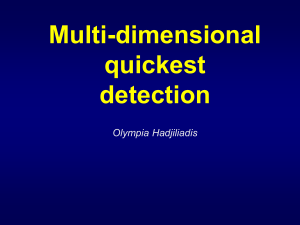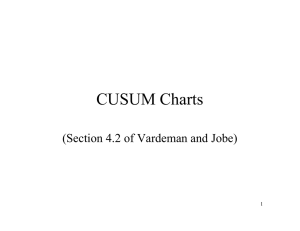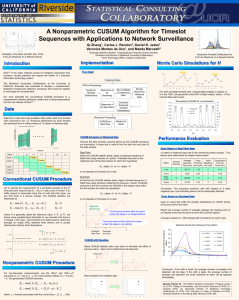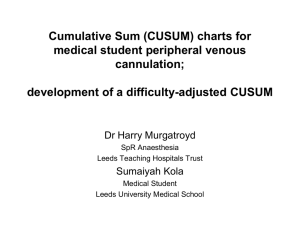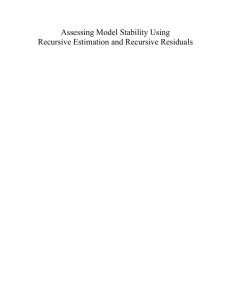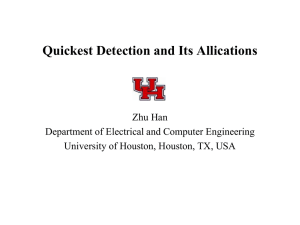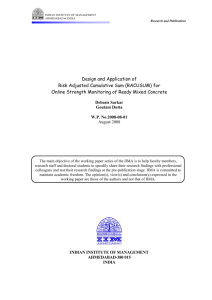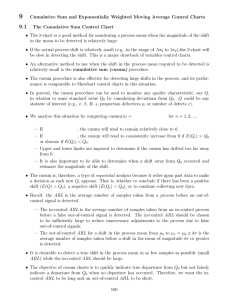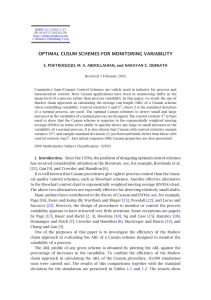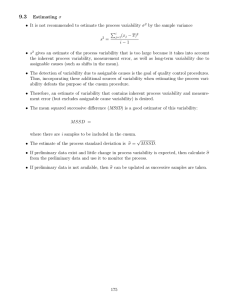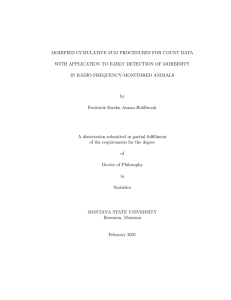Lecture 1
advertisement
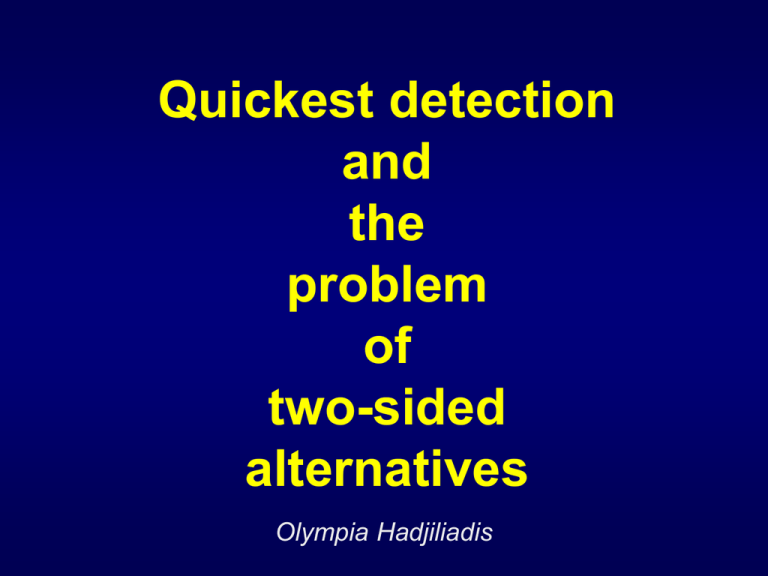
Quickest detection and the problem of two-sided alternatives Olympia Hadjiliadis Outline The change detection problem Overview of existing results Lorden’s criterion & the CUSUM stopping time The Brownian motion model with multiple alternatives A modified Lorden criterion Optimality of the CUSUM rule for 1-sided alternatives Two sided 2-CUSUM test & the HMR Further optimality issues for 2-sided alternatives & Optimality of Equalizer Rules Discussion and Open Problems The change detection problem We are observing sequentially a process t with the following characteristics: Change time : deterministic (but unknown) or random In control distribution is known Out of control can be known or unknown Detect the change “as soon as possible” Applications include: systems monitoring, quality control, financial decision making, remote sensing (radar, sonar, seismology), occurrence of industrial accidents, epidemiology etc The observation process »t becomes available sequentially; This can be expressed through the filtration: For detecting the change we are interested in sequential schemes Any sequential detection scheme can be represented by a stopping time T (the time we stop & declare the change) The stopping time T is adapted to In other words, at every instant t, we perform a test (whether to stop or continue sampling) using only available information up to time t Overview of Existing Results : the probability measure induced by , when the change takes place at time : the corresponding expectation : all data under nominal (in-control) regime : all data under alternative (out-of-control) regime Optimality Criteria They are basically a trade-off of two parts: The first is the detection delay (out-of-control A.R.L.) The second is the frequency of false alarms (in-control A.R.L.) Possible approaches are Bayesian & Min-Max Bayesian Approach (Shiryaev): is random and exponentially distributed The Shiryaev test consists of computing the statistics and stop when is optimum (Shiryaev 1978): In discrete time: when are i.i.d. before and after the change In continuous time: when is a Brownian Motion with constant drift before and after the change Min-Max Approach (Shiryayev-Roberts-Pollak) is deterministic and unknown subject to Optimality results exist only for discrete time when are i.i.d before and after the change. Specifically if we define the statistics where , the common pdf of the data before and after the change then (Yakir 1997) the stopping time is optimum Lorden’s Criterion An alternative min-max approach: (Lorden 1971) And solve the min-max problem subject to The test closely related to Lorden’s criterion and being the most popular one used in practice is the Cumulative Sum (CUSUM) test Remark: In seeking solutions need only The CUSUM statistic process Define the CUSUM statistics as follows: ; The CUSUM stopping time (Page 1954): where the threshold º is selected so that Optimality results Discrete time: when are i.i.d. before and after the change (Moustakides 1986, Ritov 1990) Continuous time: when is a Brownian Motion with constant drift before and after the change (Shiryayev 1996, Beibel 1996) 0.4 0.0 ut -0.4 mt 0.2 0.8 0.0 0.4 0.6 0.8 1.0 0.6 0.8 1.0 0.0 0.4 yt 0.0 0.2 0.4 TC WHY THE CUSUM? X1, X2,…,Xt i.i.d. -Composite hypothesis testing H0 : no change vs H1 : change at time 1 or H2 : change at time 2 or ... Ht : change at time t The Brownian motion model with one alternative We observe sequentially the process following dynamics: where the drift ¹ is known. with the Lorden’s criterion & the CUSUM The Brownian motion model with two/multiple alternatives We observe sequentially the process following dynamics: where the with the are known Remark: We are not interested in identifying which of the occurs, just in detecting the change time . Due to the symmetry of the BM, it suffices to consider the following cases: Case 1: Case 2 (Symmetric): Case 3 (Asymmetric): A modified Lorden Criterion One possible way to extend Lorden’s criterion, to include multiple changes, is in the following way: We want to solve the min-max problem with the following optimality criterion: subject to Remark: We are interested solely in the detection problem. No special care is taken for estimating the type of change (i.e. identifying i). Optimality Issues Case 1: We can show that the 1-sided CUSUM test, run for is optimal (in a sense detecting is the worst case scenario. Key point in the proof is the following inequality: 6 5 4 3 2 1 0 T2 0.0 T2 T1 m 0.2 T1 0.4 0.6 0.8 1.0 Change-point detection in B.M. model The process is: is observed sequentially deterministic: (Min-Max approach) and : are known Extended Lorden’s criterion subject to The optimal solution has to satisfy… ? Let S be a s.t. & Let U be s.t. declares an alarm at the same time as S but when “-” observations are received Construct a randomized rule V : Flip an unbiased coin. If Heads then follow U. If Tails then follow S. The classical 2-CUSUM rule And the corresponding CUSUM stopping times: Then the 2-sided CUSUM stopping time is: Notice The best 2-CUSUM OBJECTIVE: Look in the 2-CUSUM class and find the best rule ( ) in both: Symmetric case Non-symmetric case Harmonic Mean 2-CUSUM rules Non-harmonic mean 2-CUSUM rules 0.0 0.2 0.4 0.6 0.8 1.0 Harmonic Mean 2-CUSUM rules 0 .0 0 .2 0 .4 0 .6 HMR: Side results , 0 .8 1 .0 The best 2-CUSUM Symmetric case Pick i.e. a Harmonic mean 2-CUSUM rule Hence the best 2-CUSUM rules is a HMR Is it unique? Non-symmetric case ? Non Harmonic Mean 2-CUSUM rules 0.0 0.2 0.4 0.6 0.8 1.0 Case 0 .0 0 .2 0 .4 Tc 1 0 .6 Tc 2 0 .8 1 .0 ? Non-Harmonic Mean 2-CUSUM (cont.) Suppose that for big. Therefore, the event conditioned upon For general ? is Non-Harmonic mean 2-CUSUM (cont’d) change is 0 Andersen (1960) -2 -1 upl 1 2 no change The first moment change is 0 20 40 60 80 100 x The FIRST MOMENT of a 2-CUSUM rule is Non-harmonic mean 2-CUSUM (cont.) < Upper and lower bounds < Taylor (1975) Lehoczky (1977) no change change is change is Non-harmonic mean 2-CUSUM ? ? under ; change is under ; no change under ; change is change is no change change is Non-harmonic mean 2-CUSUM The first moment of a general 2-CUSUM ( Under Under Under ) Modified H.M. Eq. 2-CUSUM rules And thetwo corresponding CUSUMfor stopping Define CUSUM processes drifts times: ; EqR.: Case 2 (symmetric) For small the suggested rule is better than classical 2-CUSUM Case 3 (asymmetric) Select a modified 2-CUSUM HMR rule with Case 3 (Asymmetric): Define the class of Equalizer Rules: Theorem Proof: LHS of (2) = RHS of (1) Hence: LHS of (1) > RHS of (2) Equalizer Rules 2 1.5 2(µ2-µ1) 1 0.5 1 λ1’ λ1 2 3 λ1+2µ2 λ1’+2µ2 λ2’ 4 5 6 λ2 We can rewrite (1) as follows: 7 A comparison -mod. H.M. Eq. 2-CUSUM rules & -classical Eq. 2-CUSUM rules Non-symmetric case (cont.) Mod. H.M. 2-CUSUM EqR.: The best modified H.M. Eq.R 2-CUSUM OR Classical 2-CUSUM EqR.: Pick such that RESULT: moderate or big values of Classical better than Modified Symmetric case m=0.5 3 2.5 Classical 2-CUSUM 2 Modified drift λ 2-CUSUM 1.5 CS MS 1 0.5 0 0 0.5 1 1.5 2 gamma 2.5 3 3.5 4 Non-symmetric case m2=0.5,m1/m2=2 4 Modified 2-CUSUM HMR λ2=μ2 , λ1=2μ1–μ2 3.5 3 Modified 2-CUSUM HMR λ2-λ1=2(μ2–μ1) 2.5 C Classical 2-CUSUM ν1 > ν2 2 1.5 1 0.5 0.5 1.5 2.5 3.5 gamma 4.5 5.5 6.5 M MO The difference of the two detection delays tends to the constant: . This proves asymptotic optimality. True drifts: ¹1=1, ¹2= 1.2; Drifts used in 2-CUSUM: ¸ 1=1, ¸ 2= 1.4; True drifts: ¹1=1, ¹2= 1.5 Drifts used in 2-CUSUM: ¸ 1=1, ¸ 2= 2 Publications "Optimal and Asymptotically Optimal CUSUM rules for change point detection in the Brownian Motion model with multiple alternatives" O. Hadjiliadis and G. V. Moustakides Theory of Probability and its Applications, 50(1), 2006. "Optimality of the 2-CUSUM drift equalizer rules for detecting two-sided alternatives in the Brownian motion model" O. Hadjiliadis Journal of Applied Probability, 42(4), 2005. '‘On the existence and uniqueness of the best 2-CUSUM rules for quickest detection of two-sided alternatives in a Brownian motion model'' O. Hadjiliadis and H. V. Poor [Theory of Probability and its Applications, 53(3), 2008] '‘A comparison of the best 2-CUSUM rules for quickest detection of two-sided alternatives in a Brownian motion model'' O. Hadjiliadis G. Hernandez-del-Valle, I.Stamos. [Sequential Analysis, 28(1), 2009]
